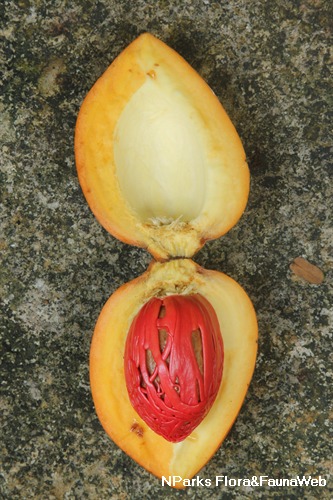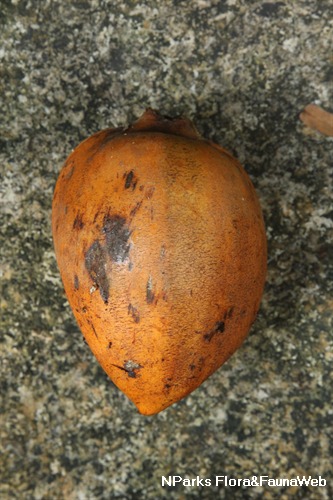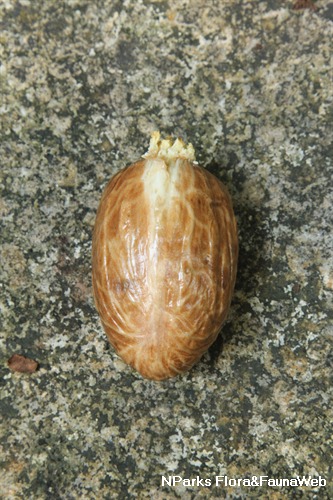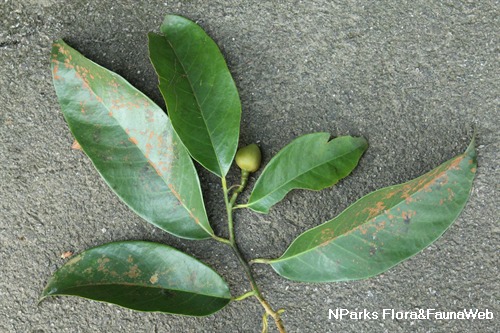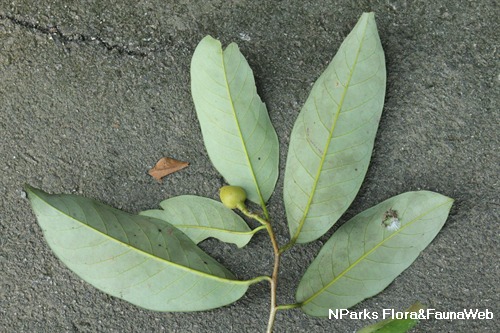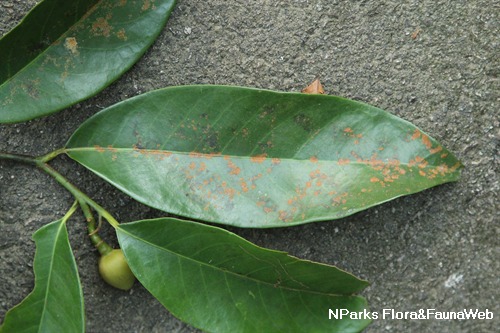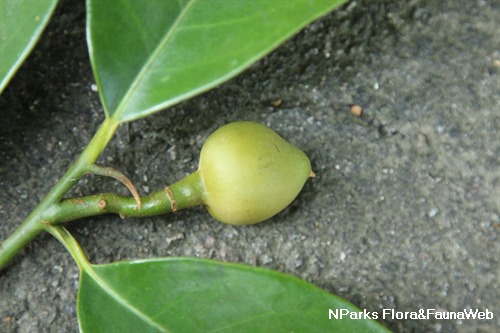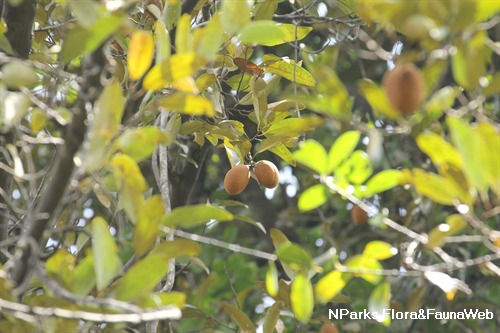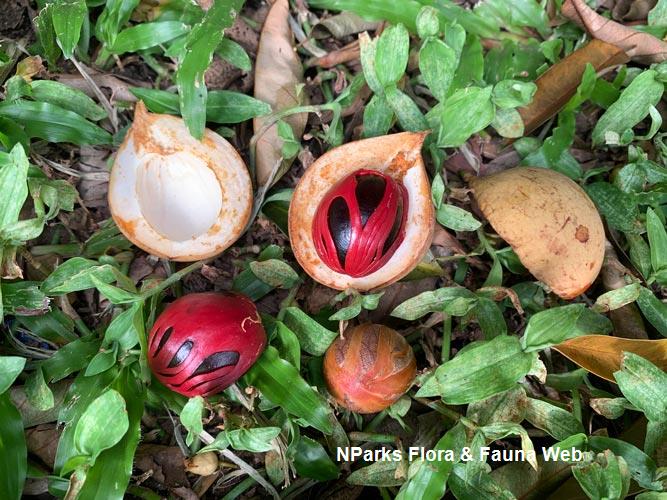
Back
Myristica elliptica Wall. ex Hook.f. & Thomson
| Family Name: | Myristicaceae |
| Synonyms: | Myristica hackenbergii Diels |
| Common Name: | Mempatoh, Pala Hutan, Pianggu, Samban, Sengkit |
Name
Classifications and Characteristics
| Plant Division | Angiosperms (Flowering Seed Plants) (Dicotyledon) |
|---|---|
| Plant Growth Form | Tree (Medium (16m-30m), Small (6m-15m)) |
| Lifespan (in Singapore) | Perennial |
| Mode of Nutrition | Autotrophic |
| Plant Shape | Irregular |
| Maximum Height | 7 m to 25 m |
Biogeography
| Native Distribution | Sumatra, Peninsular Malaysia, and Borne |
|---|---|
| Native Habitat | Terrestrial (Primary Rainforest, Freshwater Swamp Forest, Riverine) |
| Preferred Climate Zone | Tropical |
| Local Conservation Status | Native to Singapore (Critically Endangered (CR)) |
Description and Ethnobotany
| Growth Form | It is a tree 7–25 m tall, often with stilt roots or flying buttresses up to 1.2 m high. |
|---|---|
| Roots | Stilt roots or flying buttresses up to 1.2 m high. |
| Foliage | Its spirally arranged, stalked leaves have papery leaf blades that are oval or oblong, yellowish or olive-green above, with a pointed tip, greyish or pale olive-green below, covered with scattered, greyish or pale brown hairs 0.1 mm long, becoming hairless with age, with midrib flat or slightly raised above, and have 8–13 pairs of lateral veins that are flat or slightly raised above and distinct below. |
| Flowers | The plant is dioecious, producing male or female flowers on different plants. Its flowers are cream-white or reddish-yellow, sparsely covered with pale hairs 0.1 mm long, fragrant when crushed, and are arranged among the leaves in stalked flowering clusters that are sparsely covered with pale hairs 0.1 mm long. Its male flowering clusters are 1–2.5 by 1–1.5 cm and 3–5-flowered. Its female flowering clusters are 1–2.5 by 1–1.5 cm and 1–3-flowered. |
| Fruit | Its fruit is ovoid or ellipsoid-oblong, greenish-yellow turning bright orange, 4.5–7.5 by 2.5–4 cm, covered with hairs 0.1 mm long and becoming hairless with age, with a 5-mm thick fruit wall, and arranged in a cluster of 1-2 fruits. Its seeds are ellipsoid, olive-brown, 4–5 cm long, covered with an aril, and not variegated. |
| Habitat | It grows in freshwater peat swamp forests, kerangas, riverine forests, Dryobalanops rappa forests, and ridge forests, up to 200 m altitude. |
| Associated Fauna | Its flowers are insect-pollinated. |
| Cultivation | It can be propagated by seed. |
| Etymology | Greek myristica, myrrh-fragrant, referring to true nutmeg, Myristica fragrans; Greek elliptica, elliptic, referring to the shape of the leaf blade |
| Ethnobotanical Uses | Timber & Products: The timber has been reported to be good. |
Landscaping Features
| Landscaping | It is suitable for parks, especially in waterlogged areas. |
|---|---|
| Desirable Plant Features | Ornamental Fruits, Ornamental Form |
| Landscape Uses | Parks & Gardens, Riverine |
Fauna, Pollination and Dispersal
| Pollination Method(s) | Biotic (Fauna) |
|---|---|
| Seed or Spore Dispersal | Biotic (Fauna) |
Plant Care and Propagation
| Light Preference | Full Sun, Semi-Shade |
|---|---|
| Water Preference | Lots of Water, Moderate Water |
| Plant Growth Rate | Moderate |
| Rootzone Tolerance | Moist Soils, Waterlogged Soils (Drains Site) |
| Maintenance Requirements | Moderate |
| Propagation Method | Seed |
Foliar
| Foliage Retention | Evergreen |
|---|---|
| Prominent Young Flush Colour(s) | Green |
| Young Flush Texture(s) | Papery |
| Foliar Type | Simple / Unifoliate |
| Foliar Arrangement Along Stem | Alternate |
| Foliar Attachment to Stem | Petiolate |
| Foliar Shape(s) | Non-Palm Foliage (Oval, Oblong) |
| Foliar Venation | Pinnate / Net |
| Foliar Margin | Entire |
Floral (Angiosperm)
| Flower & Plant Sexuality | Unisexual Flowers , Dioecious |
| Flower Colour(s) | Cream / Off-White, Yellow / Golden |
|---|
| Flower Grouping | Cluster / Inflorescence |
| Flower Location | Axillary |
| Flower Symmetry | Radial |
Fruit, Seed and Spore
| Mature Fruit Colour(s) | Orange |
|---|---|
| Fruit Classification | Simple Fruit |
| Fruit Type | Dehiscent Dry Fruit , Capsule |
Image Repository
Others
| Master ID | 31887 |
|---|---|
| Species ID | 6288 |
| Flora Disclaimer | The information in this website has been compiled from reliable sources, such as reference works on medicinal plants. It is not a substitute for medical advice or treatment and NParks does not purport to provide any medical advice. Readers should always consult his/her physician before using or consuming a plant for medicinal purposes. |

